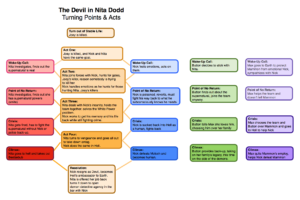I Have a Plot (No, Really)
So after much cogitation and wailing, I have a plot for Nita. It looks like this:

The yellow boxes in the center are the first turning point (the turn out of the stable life) the four acts and the resolution/new stable life.
The other boxes are the PoV characters’ plot turning points, red for Nita, blue for Nick, Green for Button, and purple for Max.
It’s pretty, isn’t it? More than that, it’s useful because it’s based on these assumptions (my assumptions for my plotting, not rules, not industry standards, just Crusie’s Theory of Plotting. WARNING: Spoilers abound below.
Characters begin in a stable life that they’re immediately thrown out of (first turning point).
They will cling to their old stable lives until something happens that’s so revolutionary that they must change to adapt to the new normal (second turning point/wake-up call).
They will try to incorporate the new normal into the old normal, adapting as they go but still under the assumption that they can go back to where they were until something happens that’s so revolutionary that they realize they’ve changed too much to ever go back: Everything is different now (mid turning point/point of no return).
They will pursue their goals with new energy, coping with the new normal and their new future, trying to establish secure footing when something happens that’s so devastating that they realize they’ve lost their battle unless they do something radical, something they’ve never done before, something they’re not sure they’re capable of but have no choice but to plunge into: (penultimate turning point/crisis/going to hell).
The last act is their Final Push, the do-or-die obligatory scene with the antagonist, the Great Battle and the final turning point (the climax) which will thrust them into a new stability (the resolution).
Each of those turning points is represented by an event, something that happens that affects the characters enough that they turn and in so doing turn the plot. Joey is killed, and Nita and Nick investigate which leads to the wake-up call: Nick kills Rich to save Nita, who now knows the supernatural is real. Galvanized by the knowledge that Nick is getting closer and Nita now is fully read in to the situation, the big bad speeds up poisoning Nick, which leads to the point of no return: Nick can’t remember anything after 1502 but he knows he’s missing something and Nita now has to take over as Hell’s lead investigator. They both keep fighting, at which point the Big Bad created the crisis point by putting out a contract on Nita and sucking Nick back into Hell as a vulnerable human, thinking they’ll be weaker fighting alone (and forgetting that unlike other Devils and Devil Spawn, they have friends).
These turning points pull the story together because they pull the characters together: Nick and Nita meet because Joey dies, but they’re pulled together because they both want to solve his murder. Their attempts to do that bring Button and Max into the story. Nick and Nita begin to bond because he kills Rich to save her, and they assemble a team that Button and Max will be drawn into in Act Two. When Nick is kidnapped back into Hell, that forces all four characters to cross boundaries in an effort to save him and the island. Each turning point raises the stakes and deepens the investment each of the characters has in the fight and in each other, and sends them into the next acts as new people fighting a harder fight. As another writer once said, each turn of the screw tightens the plot.
The key to pulling it all together is that those individual character turning points roughly correspond to each other, usually in response to the same event. In the first turning point, for Nick and Nita it’s the showdown with Rich that convinces Nita that the supernatural is real and forces Nick to the realization that he’s having emotions again, since he killed his best witness to protect Nita. Button’s comes when she agrees to have lunch with Lilith to get information out of her, siding with Nita against the police department. And Max’s comes when he sympathizes with Nick in the scene in the Pandemonium and begins to doubt his boss. Button’s and Max’s TPs aren’t directly in sync with the Nick and Nita’s TP, in part because their lives aren’t that closely aligned to Nita’s and Nick’s yet, but they’re tied to it by the same plot line: trying to solve the supernatural crime on Earth. That’s a loose tie, so I have to make sure the next one is tighter. Which the midpoint TP is: The event is Nick succumbing to the poison and losing all memory past 1502, making the others step up: Nita accepts her powers and takes the leadership of the supernatural team; Button sticks with Nita even though she’s still in shock from learning the supernatural is real and has an inherited antipathy for demons; Max sees Nick vulnerable and doesn’t tell Mammon, trying to do the smart/right thing instead of what’s best for his boss.
The biggest gift of the individual character TPs is that it tells me what’s in the acts. Now I know exactly what character arc has to happen in those acts for those people and I can rewrite so that the actions they do create that arc.
I love turning points. They make plotting so much easier.
SaveSave
SaveSave
SaveSave
SaveSave
The post I Have a Plot (No, Really) appeared first on Argh Ink.




